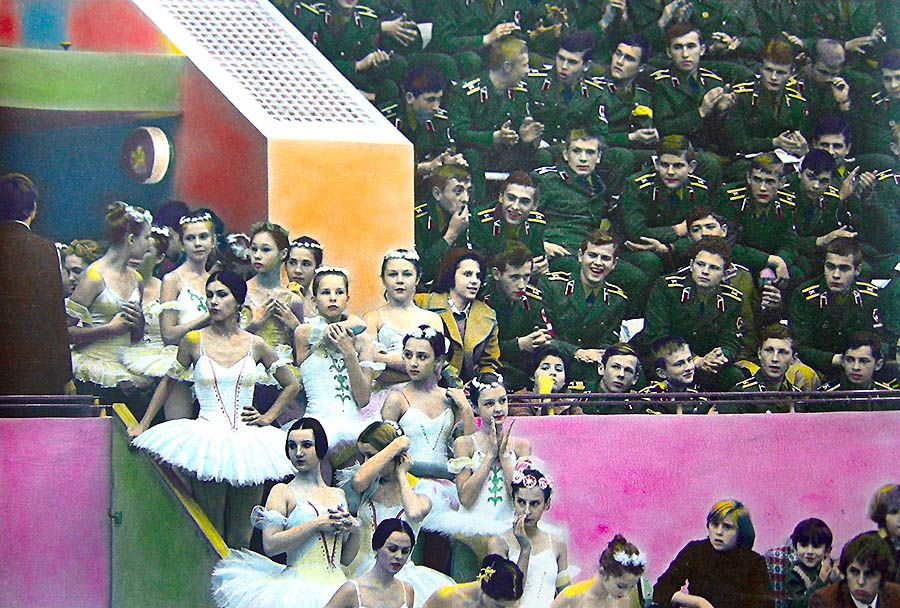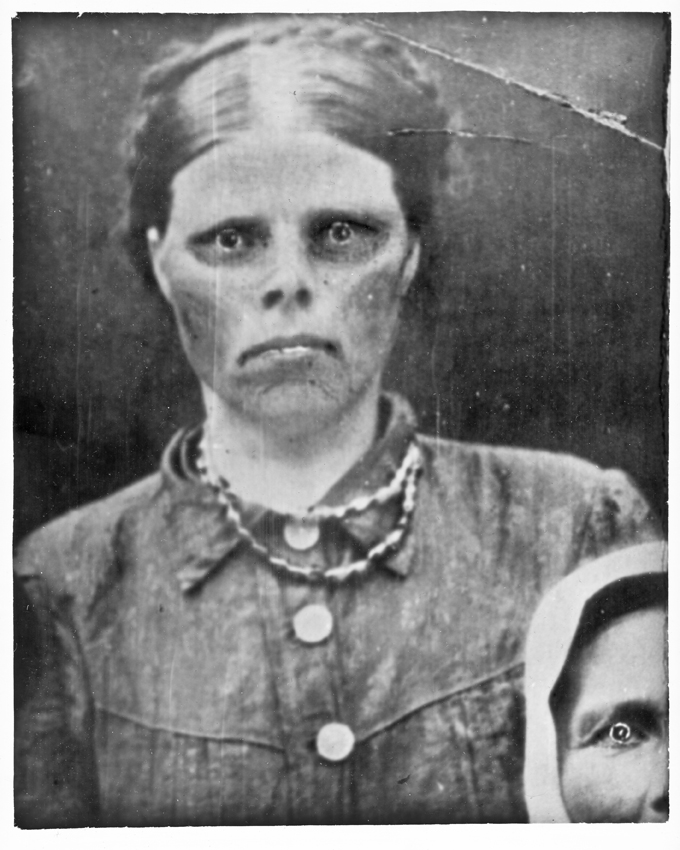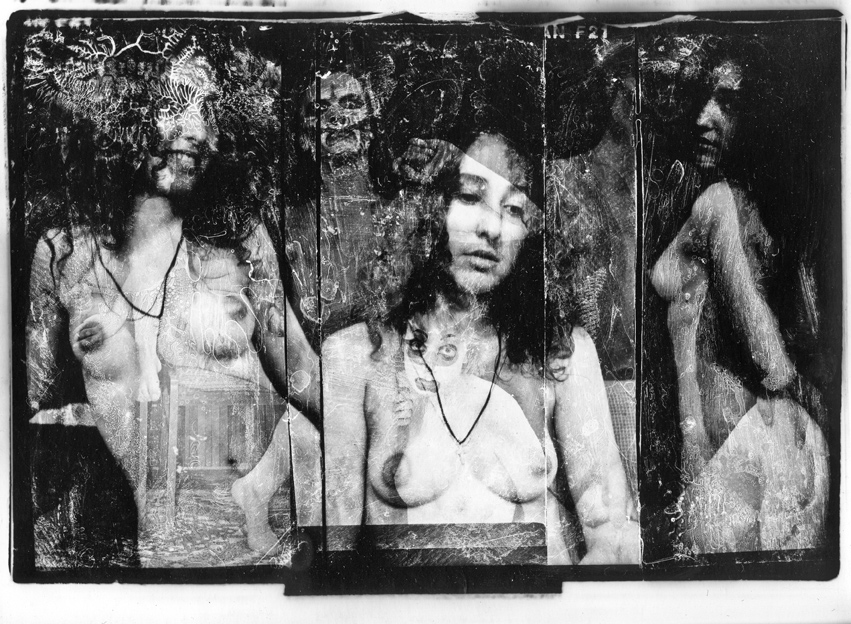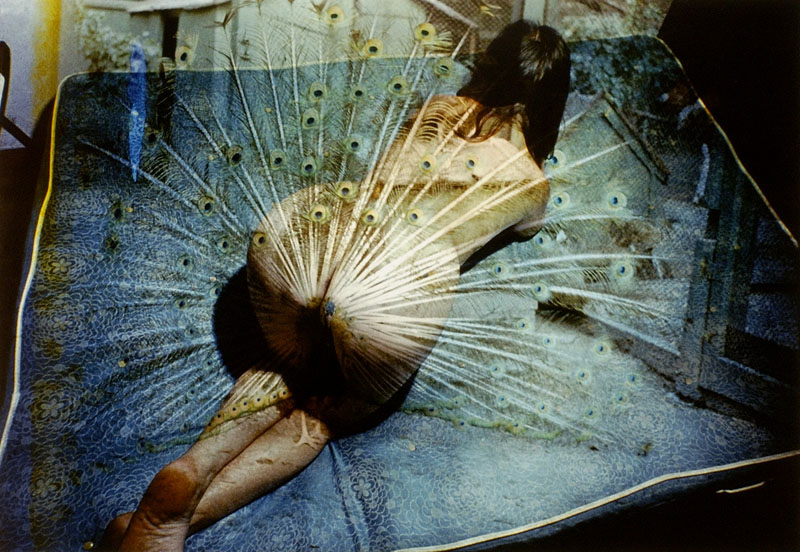Rui Cepeda. Historical (Cultural) Dysfunction and Disarrays: On the Kharkiv School of Photography

© Victor Kochetov. From Vintage series, 1983
It is paradoxical to try to form an overview of an oeuvre that is culturally contextualized when I do not have the proximity or participative knowledge about it, only a critical distance from what has happened in one of the territories of what was once known as the Union of Soviet Socialist Republics. Throughout its history Ukraine has been a piece that is part of a constantly fragmented mosaique, from which those territories (that are part of it) tend to represent different moments through time Europe’s perspectives, or, in other instances, they share of closer proximity to. It is within this context that its own individual history and outputs, like a school of thought/practice, should be understood even when with a tangential approach to more Westerner political and cultural perspectives. The comments developed on the history of photography during the second half of the 20th century, while having an approach to the Kharkiv School of Photography (a visual approach that emerged and was constituted in the 1970s by a group of photographers, under the name of Vremya (‘Time’), and which shared and proposed a vision distinct from that imposed by the Soviet official doctrine) will be helpful to find the convergences, divergences, and tangencies within an artistic context from a Western perspective. A view that would make it easier to make sense of the time and space that encompasses us and can contribute to tracing down historical (cultural) dysfunctions and disarrays within a global context.
In the designated Western world, throughout the second half of the 20th century, the fear of a centralizing communist socioeconomic structure being imposed over one in where the means of production were largely, or, entirely, privately owned and operated for profit hung around for more than four decades; as well as the persistent fear and the blind belief of an existing threat of nuclear warfare on a global scale. The socio-political context, throughout what is now known as the Cold War (between the late 1940s and 1991), framed the outcome of images that were focused on a political ideology that suspended the continuation of being while holding time still. In contrast to images from the World War II period, those by Joe Rosenthal (1911—2006, US), Robert Capa (1913, Hungary — 1954, Vietnam), Alfred Eisenstaedt (1898, Germany — 1995, US), Yevgeny Khaldei (1917, Ukraine — 1997, Russia), or Leni Reifenstahl (1902—2003, Germany), showed another reality: an ideological idea with models for the perfect environments or bodies, leading and charismatics figures posing while facing challenges. These new images — those about the American Dream and the Soviet Utopian Dream — had arisen from a necessity to stir doubt about the war’s goals and the deprivation soldiers had to endure in common. As international tensions continued to rise between the two political blocks in Europe — Western and Eastern — an anti-communist position, underlined by the love for pleasure and life (in certain parts of the Western world), leads the way; while, in others, it takes the form of a mad-hysteria (in the US throughout the 1950s with McCarthyism) underlined by a love for weapons and death; and, on another, by an antithesis, by the anti-capitalist position which, accordingly with the accounts of the day, was a reflection of what was happening on the other territorial extreme. Historically, the year 1989 has become the landmark threshold for a transformation in discourses about established normativeness, after which we still had to go one more decade of rumors and side play.

© Evgeniy Pavlov. The Violin, 1972
If throughout the 1960s and 1970s artists, and other creative individuals, started to question the conditions of possibilities relating to the institutional and cultural variables, in the following two decades they inquired upon those conditions but associated them instead with the social and economical variables. Since then, society at large has been going through the slow process of adjusting and synchronizing the heavy machinery that governs and institutionalizes the public sphere to the transient fashion of the moment, the coming of the body. Within a capitalist system the privatization of the body — where we decide what we want to do with our own body — has become the first and most important privatization. In the last decades of the 20th century, the body emancipated itself from the state, from religion, from the prevailing orders, and groups that govern contemporary society’s production, reproduction, and demand.
Coincidentally, throughout the globe, a strong political movement with a post-colonial discourse started to gain relevance and importance in the geopolitical arena: questions of cultural perception developed, and ways of viewing and of being viewed were reinvented. Meaning discourses — essentially cultural — through the voice of Léopold Sédar Senghor or Aimé Césaire culminated in the seventies.
The use given to history and historical narratives creates the impression of unity. A unique and singular state that is concerned with the idea that there are people destined to live in isolation, to live deprived, to live without, to live only one story drawn under vested interest (by the few), to a convenient mesmerizing destiny involving the whole; as Hobsbawm wrote, “traditions are invented by the sake of political discourses or ideologies.” In the midst of the Cold War, in the 1960s, the art community (artists, writers, and photographers) stopped having a stable field to look for references of belonging and being. The reality, as it was presented and lived throughout the 1940s and 1950s, was too muddy and illusory. It was shown as a perfect and ideal golden bowl, though, with cracks invisible to the naked eye. Throughout this historical period, photographers like the Swiss-born Robert Frank (1924, Zürich. Lived and worked in the USA), with his field project, The Americans (1958), or Diana Arbus (1923—1971, USA), with her photographic work on the deviant and marginal people of the U.S., used their camera to denote the shallowness of the leading institutional force in imposing controlling realities and dissatisfaction with a society that was being put up as the perfect state (the American Dream on one side of the Atlantic and the Socialist welfare state, on the other side). The Kharkiv School of Photography’s aesthetic principles share some of the same inquisitive criticality about the Soviet utopian dream of dysfunctions and disarrays. With a sturdy work, they both engaged in capturing images that showed the bowl’s hidden cracks, and dystopian realities meanwhile influenced the development and the photographic approach taken by many other photographers and artists during the following decades — particularly in the photo-social documentary. This emergence has implied redefinitions of the classic theory concerned only with social and economic variables and requires one to also have a look at the institutional and cultural factors.
After the Second World War, artists did not know where to look and what to portrait without being linked to one of the existent socio-political ideologies ruling the discourses at the time — i.e. Capitalism, Socialism, or Communism. Although artists tend to represent contemporary society vices and virtues through their works, as usual, when not abiding with the ruling and normative discourses they are considered as dislocated and are put at the margins of society for society’s sake. If, with the 1960s, a more neutral, aggressive, and iconoclastic language emerged in the visual arts (Robert Rauschenberg, William Eggleston, Ed Ruscha, Bruce Nauman, just to name a few), in the following decade this approach was carried on further by the Düsseldorf School (Joseph Beuys, Gerhard Richter, Bernd & Hilla Becher, Andreas Gursky, Thomas Ruff, Thomas Demand, Thomas Struth, and Candida Höfer) in Germany, or David Hockney and John Davies in England, and Guy Le Querrec and Raymond Depardon in France. At this point, artists had started to look into one of the most prominent subjects of works in art history — the body, the self, the being. Alternative realities had to be found or created: Helmut Newton’s (1920, Germany — 2004, US) and Richard Avedon’s (1923—2004, US) bodies of work are counterexamples of work that was developed by Evgeniy Pavlov, with The Violin (1972), or Juri Rupin, with The Sauna (1972). Psychedelic and dissociative discourses regarding one’s own place in the world started to converge on a global scale. In the 1980s, the work by Roman Pyatkovka (1955, Ukraine) and Joel Peter Witkin (1939, US) shared some technical resemblance when combining scratching the original film with the conceptual exploration of representations of the human body and flesh; or, a documentary approach to society in Christian Boltanski’s Chases School, 1986—1987, with poignant mementos referring to the Jewish Holocaust. Photographers played within a framework that contested theories of cultural imposition and perspective while bringing neutrality of the photographic object in where it means whatever it means to individual viewers.

© Roman Pyatkovka. Holodomor. Phantoms of the '30s, 19901
Consequently, from the mid-1980s onward Conceptualism, as a movement in art, and Social Documentary (situated on the threshold between critical representation and factual reporting) were disseminated around the world. In some moments they converge and intertwine; in others, they are two completely distinguished sets of attitudes, observing the function of art in society and societal adaptations to specific political, economic, or cultural ideas. This is a condition that is quite visible in the images generated by the Kharkiv photographers who used photomontages, hand coloring, or a combination of the two techniques. In these works, the relationship between the artist (photographer), artwork (photography), and the audience is the focus. Boris Mikhailov’s (1938, Ukraine) photographic work, Unfinished Dissertation (1984—1985), and Marcel Broodthaer’s (1924, Belgium — 1976, Germany) installation, Musée d’Art Moderne, Département des Aigles (1968), interrelated those attitudes and offered an institutional critique. In particular, a criticality related with those various institutions that drive society at large and, more specifically, the work of art institutions, such as galleries and museums, and the conventions in society and art.
From a critique that unraveled, uncovered, and critically re-examined (throughout the 1960s, 1970s, and 1980s) the convincing logics and operations of the post-war truths (claimed from 1945 until the late 1960s), the criticality brought upon by the 1990s onwards aims to recognize the limitations of one’s thoughts. While making visible historical and social constructed boundaries between the ‘we’ and the ‘other’; between what is from the inside and the outside; what is from the public and private sphere. In where “one does not learn something new until one unlearns something old, otherwise one is simply adding information rather than rethinking a structure.” When one would expect the homogenization of discourses, the array of different cultural values and expressions has become overwhelming. Photo-social documentary or social-realist photographers, like Elliott Erwitt (1928, France), Gilles Peress (1946, France), Chris Killip (1964, UK), and Antoine D’Agata (1961, France), create images documenting fear, desire, drugs, and sex, in the tradition of Nobuyoshi Araki (1940, Japan) or Nan Goldin (1953, US). All are focused on somatic needs, as opposed to the needs of the spirit or other non-physical entities like the State and nationalistic ideologies.
Since the end of the Second World War, there has been a prevalent hegemony of discourses associated with the political left which thinks through and relates what is happening both in the private domain and public sphere to economic and social variables in the media, in political parties, in culture, and the arts. In particular, because those political regimes that were deposed in Western Europe (Germany, Italy, Spain, and Portugal) were associated with political discourses imposed by a particular authoritarian political right — that which thinks through and relates those things happening to cultural and institutional variables. Since then, the West has been living an alternative of the same left. Ukraine, in contrast, has lived under the dictatorship of the left for several decades. The difference between the two lies in the reality that some political discourses are closer to the left than others. The counterculture/social revolution of the 1960s that brought into the main arena a discourse about the body (epitomized by the hippies’ countercultural movement in the U.S. during the mid-1960s and the French sexual revolution of 1968, in Western Europe), and, even more, with the advent of the Internet, communication of ideas and access to information went beyond political parties, institutional impositions, and national discourses; beyond the Utopian projects and leading toward the body, the self, and the being. With the Internet and digital information has emerged a more conjectural language, knowledgeable attitude, and participative audience that both conjure the intangible element brought by the Internet and the bodily needs of the being and the flesh.

© Roman Pyatkovka. Games of Libido, 1995
Consequently, migration on a global scape along with this increasingly fast means of communication means that artists from the most recondite places in the world can have their voices heard. An ongoing negotiation of cultural differences exists in our everyday lives; social changes occur on both sides of the communication process. New predications take place! New connections are being made and created way beyond conservative views or utopian ideals.
Before pixels were deluging the world, artists introduced new topics on the discourses that challenged those that were by far already established. They pointed to other relational structures of possibilities in art history and social relations, and the distance between the private domain and the public sphere. Take, for instance, The Finest Art on Water (2011) by German artist Christian Jankowski as a culmination of the discourses used by artists in the 1960s, testing the boundaries between high art and mass culture, and following a Pop tradition, which explores the concept of what is banal and mundane as characterized by the English artist Richard Hamilton (1922—2011)2. In the meantime, other contemporary artists, such as Francis Alÿs (1958, Belgium), Rirkrit Tiravanija (1961, Argentina), Pierre Huyghe (1962, France), Philippe Parreno (1964, Algeria), and Anri Sala (1974, Albania), have been focusing their discourses on perversion, obsession, horror, fear, trash, and the pain resulting from controlling forces. Through their work, these artists have been underlining a position in a social-cultural body that is filled with sensations, making us laugh, and at the same time, educating us about the diversity of discourses, false hegemony, and an obnoxious, coked-up version of supposedly extra-real reality where objects have feelings without us.
By intersecting the conceptual and realist frameworks, the contemporary artist (photographer) asks its audience to rethink the structure of power imposition, which has previously separated artistic disciplines/practices. They create sceneries, montages, and construct apparatus, objects, and technical images as subjects. From sculpture to painting, photography to video and digitally-based art forms, contemporary artists are dealing with society’s non-visible controlling forces, which take the shape of the State, Church, economy, sexuality, images, and drugs. A change, due in part, to the realization by society at large and photographers in particular, that the medium’s power for deception is built on a belief of its documentary verity, its inability not to pay equal attention to all that has come through the camera’s aperture, as was expressed by the English art critic, John Berger (1926), in his 1972 seminal BBC four-part series and accompanying book, Ways of Seeing. The work by the American conceptual artist, Barbara Kruger (1945, US), incorporates and addresses that concurrent bigotry like order-words. She plays between what is, from strange-familiar places through the combination of image and text, and the use of a directed language and pronouns such as 'I,' 'you,' 'we,' 'they,' and 'your,' whilst underlying their iconic social position in the social-cultural body. Fear is a feeling that has been explored, in a subliminal way by the different political power institutions, by those who have been governing the distinctive geo-cultures around the globe, since after the Second World War.

© Boris Mikhailov. Overlays, 1968—1981
Photography’s verisimilitude and reliable visual reproduction of what 'is,' by nature makes it the most neutral vision in cultural production — a means to democratize knowledge derived from sense-experience. Nonetheless, throughout its history, photography's democratic neutrality and objectivity have been questioned on multiple levels: from the interpretation of ideas disclosed by images to humankind’s technological achievements. However, photography processes and records images independently of the physical ability or mental intentions of who takes the picture. It draws from nature through means of light. It is the ability and intentions of those who take the pictures, the photographers, which should be contested. An image is fixed on a tangible support by a technological process, being those, a piece of metal or paper, cellulose acetate, or electronic material. Most importantly, however, photography began to alter the human relationship with memory — the neuropsychological process of communicating encoded, stored, and retrieved information. It has become a physical and chemical stimulus, a second memory, storing information over periods of time in an objective, effortless, and independent way. The sense of being there, of a personal encounter, connected individual experiences through images produced as genuinely akin to actual experiences, and, moreover, the ideal of democratic access to information.
The present-day focus on photographers and artists might have started with a message sent between UCLA and Stanford University in 1969. However, two decades later, the Internet has invaded our homes, establishing itself as its rightful owner, while mediating our deepest secrets and becoming our artificial confidant. Through Facebook, Instagram, Tumblr, present-day society shares its most intimate thoughts as recycled images. Living a simulacrum in which society is more concerned with maintaining and reproducing an illusion, at any cost, rather than living the reality. Average people engage in a mass reproduction swept along the stream of images provided by those apps, appropriating them, while adding something to their understanding.
Nonetheless, the dichotomy here, with the Kharkiv School of Photography, is their found freedom and how this school of thought/practice has been occupying and existing within this new condition of possibilities. After 1989, with the disintegration of the USSR into nation-states, the playing field that was previously forbidden — for instance, images of naked people, particularly woman, which could have been considered representations of political independence from a centralized state — have become a fashionable obsession; whereas, before 1989, it was a contested playing field about the cultural dysfunctions and disarrays brought by socio-political imposition and institutional idealization. This does not mean that photographers prompting Kharkiv's thoughts continued to rematerialize the world with only sexual and erotic imagery. Vladyslav Krasnoshchok (1980) and Sergei Lebedbnsky (1982), who founded the Shilo group in 2010 with Vadym Trykoz (1984), visually reconsider the heritage of both the Kharkiv School of Photography and Josef Koudelka’s Prague Spring photographs; and Roman Minin’s (1981) participatory art, integrating the masses, links to the practices of such artists as Rafael Lozano-Hemmer (1967, Mexico), and the Mexican muralists, David Alfaro Siqueiros (1896—1974), Diego Rivera (1886—1957), and Jose Clemente Orozco (1883—1949), whose works attempted to educate the masses through large-scale interventions on building facades. The Kharkiv photographic works are a clear encouragement and example of paralleling Western artists interested in the socio-cultural inconsistencies of how the body is and occupies existing space. Some photographers continue to play with the social realism that characterized previous generations, while others explore relationships and existing possibilities between what is conceptual and what is realistic.

© Shilo group. Euromaidan, 2014
While photography is used in the same way — as a means of, and for, social and political comment — what distinguishes the different sides discussed here (the Western perspective from the Kharkiv School of Photography) is the playing field. In the latter, the realistic depiction of contemporary life as it was under a more constrained freedom is still the playing ground; in the former, the playing field has become those virtual platforms that exist as memory aids, substituting the body, the being, and the self. With the Internet connecting realities and feelings, and the array of digital supports flooding the globe, the first thought that comes into my mind is that information technology has substituted our memory, skills, and knowledge like prostheses; like the idea of Noah’s Ark as being a big transitional USB pen packed with data, 0’s and 1’s; or, being an aesthetic white cube, in which data is stored and displayed for buyers, i.e. collectors or investment funding trusts, just like the data storage centers are immaculate spaces free of that horrifying external and timeless thing that dust is.
The body is all that remains to us of the real, with its still unique capacity to suffer, enjoy, feel.
The second significant idea that derives from the practice of present-day artists is aimed towards works functioning as physical archives for non-physical images, works existing only on the Internet (Google search or Facebook albums). Those found images or, instead, images that are taken from that archive (Internet) contaminated by non-visible metadata. This creates narratives and dissociates / associates images that are mediated by the archive itself; or, what follows the confrontation of and the creation of new subjectivities, as those images that are presented by the photographer Mishka Henner (1976, Belgium) when reframing depictions taken from Google Earth. All photographers play with photography and the act of not taking photographs as well, instead of looking to find the differences between two 'equal' images. It is where we have to connect what relates and brings together what seems to be different in images; it is where we have to connect the equal to be at rest — to be hegemonic. Whilst the whole idea is to establish an alternative to the dominant archive and interfere in how we educate, set our gaze. But, as I wrote at the beginning, this is just one side of the discourse about a school of thought and practice.
Bibliography:
Berger, J. (2008) Ways of Seeing. London: Penguin Classics.
Hobsbawm, E. and Ranger, T. (Ed.) (2012) The Invention of Tradition. Reissue edition. Cambridge: Cambridge University Press.
Latour, Bruno (2001) ‘What is Iconoclash? Or Is there a world beyond the image war?’, Bruno-Latour.org’s website</i [Online] [Accessed] Available from http://www.bruno-latour.fr/node/64
Rogoff, Irit (2006) ‘Irit Rogoff: What is a Theorist?’, Kein.org [Online] [Accessed February 26th, 2013] Available from http://www.kein.org/node/62
Warner Marien, M. (2002) Photography: A Cultural History. London: Laurence King Publishing
1. A series dedicated to the Great Famine of 1932—1933 in Ukraine, the Holodomor (‘killing by hunger'), when millions of people were forced to starve to death by Josef Stalin, with a death toll ranging from 1.8 to 12 million people. A parallel can be made with the Great Chinese Famine, from 1958 to 1962, in where China experienced a monumental famine that killed at least 45 million people due to essential two causes: natural disaster and communist policies.
2. In 1957, Hamilton listed the characteristics of Pop Art, as popular (designed for a mass audience), transient (short-term solution), expendable (easily forgotten), low cost, mass-produced, young (aimed at youth), witty, sexy, gimmicky, glamorous, big business.
This essay was originally published under the copyright of the VASA Project and the author
Rui Cepeda (Ph.D. in Arts): Art entrepreneur, critic, and analyst based in London
